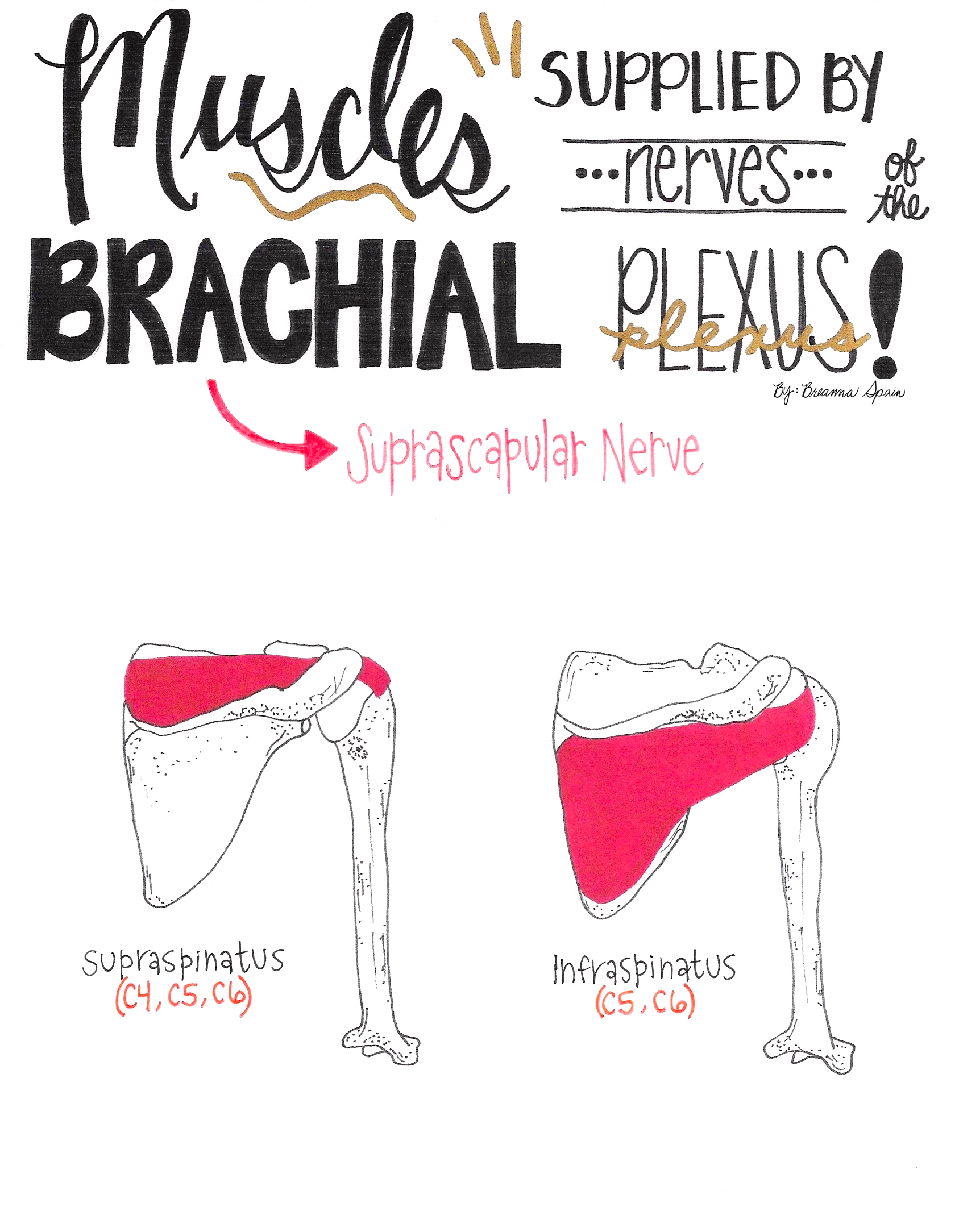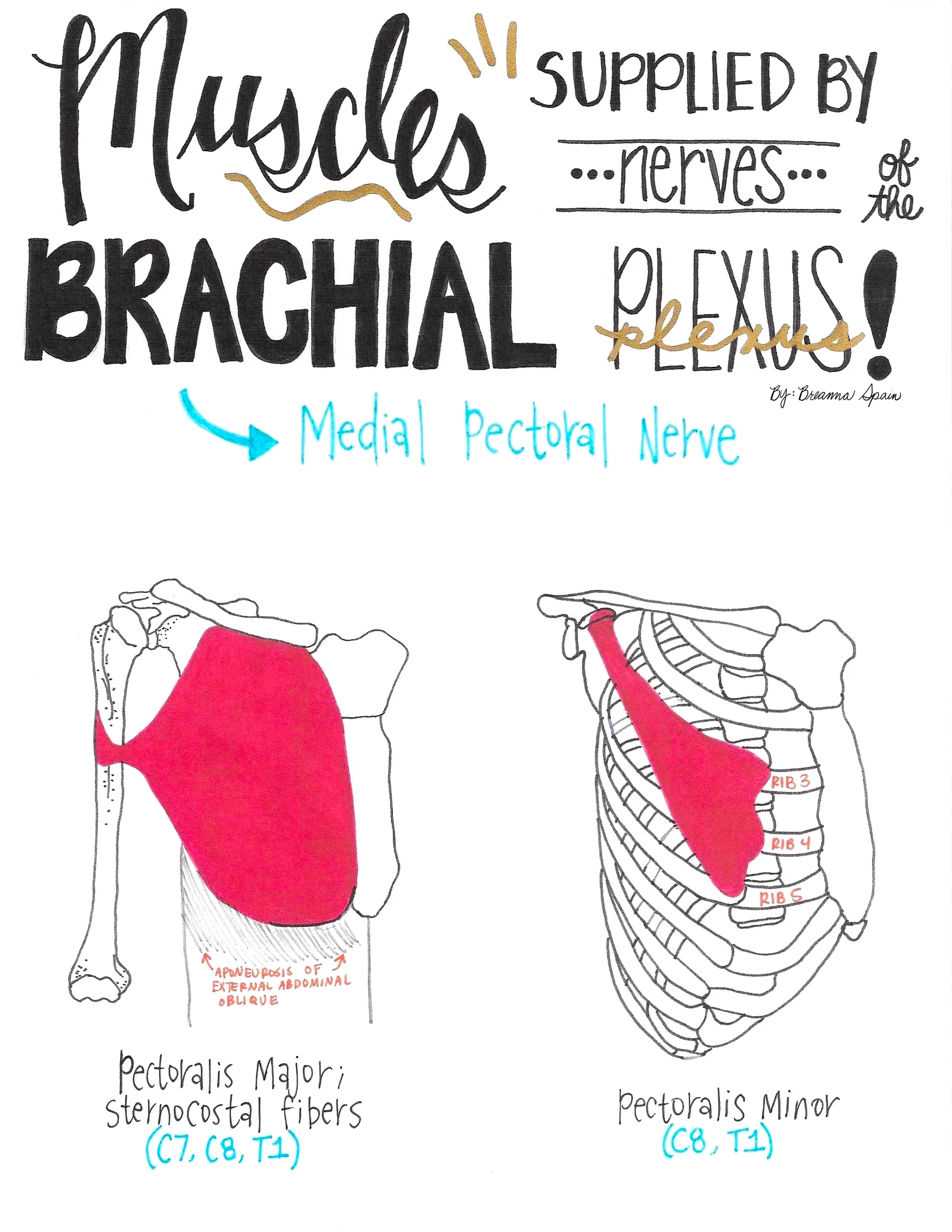Happy Friday everyone! Today I am sharing my next series of anatomy drawings, which will be all about the brachial plexus, its different components, and how it supplies sensory and motor innervation throughout the arm, forearm, and hand. The brachial plexus can be very tricky. One of the best ways I was able to visualize it and learn how it works was in cadaver lab. After you’ve seen it in illustrations a million times, it’s really crazy and fascinating to see all of its intricate routes in real life with a good dissection. After the brain and heart, this was probably my next favorite thing to see in a cadaver.
This post includes my drawings of the brachial plexus and how its terminal branches (musculocutaneous, axillary, radial, median, and ulnar nerves) branch and travel throughout the arm. I have included short, simplified breakdowns with each picture. So, if you are looking for a specific nerve, you can click COMMAND+F or CONTROL+F to find that exact one. Please feel free to share, save, download, or even print these pictures for study tools of your own.
You can purchase an organized, collective PDF of these drawings and explanations via the link below.
This 39-page PDF includes drawings and comprehensive explanations of 30+ nerves that originate from the brachial plexus and their course through the upper extremity, including the median, axillary, radial, musculocutaneous, and ulnar nerves.
Note: If there is ever a discrepancy between the information in my notes/drawings and what is taught to you in your program, please always go by the information that is specific to your own curriculum.
The Brachial Plexus
(2D Version)
(3D Version)
The brachial plexus is made up of 5 main components:
ROOTS: the main nerve roots that make up the brachial plexus are C5, C6, C7, C8, and T1.
TRUNKS: the brachial plexus consists of superior, middle, and inferior trunks.
DIVISIONS: the brachial plexus consists of anterior and posterior divisions.
CORDS: the brachial plexus consists of lateral, posterior, and medial cords.
BRANCHES: the terminal branches of the brachial plexus include the musculocutaneous nerve, the axillary nerve, the radial nerve, the median nerve, and the ulnar nerve.
Nerve Supply to Musculature
*Remember that muscles do not receive all roots from their innervating nerve i.e. the suprascapular nerve is compromised of the C5, C6, and sometimes C4 nerve roots; the supraspinatus muscle is innervated by the C4-C6 nerve roots, but the infraspinatus muscle is only innervated by the C5 and C6 nerve roots*
Muscles/areas that are innervated by the supraclavicular nerves:
Dorsal scapular nerve: levator scapula, rhomboid major, and rhomboid minor
Long thoracic nerve: serratus anterior
Nerve to subclavius: subclavius
Suprascapular nerve: supraspinatus and infraspinatus; sensation to the acromioclavicular and glenohumeral joints
Muscles/areas that are innervated by the infraclavicular nerves:
Lateral pectoral nerve: pectoralis major (clavicular fibers); sensation to pectoralis major
Upper subscapular nerve: subscapularis
Thoracodorsal/long or middle subscapular nerve: latissimus dorsi
Lower subscapular nerve: subscapularis
Medial pectoral nerve: pectoralis minor, pectoralis major (sternocostal fibers)
Medial brachial cutaneous nerve: sensation to skin of the medial arm
Medial antebrachial cutaneous nerve: sensation to skin over the biceps brachii and skin of the medial forearm
Muscles/areas that are innervated by the terminal branches:
Musculocutaneous nerve: coracobrachialis, biceps brachii, and brachialis
Lateral antebrachial cutaneous nerve: sensation to skin of the anterolateral and posterolateral forearm
Axillary nerve: deltoid and teres minor
Superior lateral brachial cutaneous nerve: sensation to skin over the inferior deltoid
Radial nerve: triceps brachii, brachialis, extensor carpi radialis longus, brachioradialis, and anconeus; sensation to skin of the posterior arm and forearm
Superficial branch of the radial nerve: sensation to skin over the snuff box and the posterolateral 1 and 1/2 fingers (excluding the nailbeds)
Deep branch of the radial nerve: extensor carpi radialis brevis
Posterior interosseous nerve: extensor digitorum, extensor digiti minimi, extensor carpi ulnaris, supinator, abductor pollicis longus, extensor pollicis brevis, extensor pollicis longus, and extensor indices
Inferior lateral brachial cutaneous nerve: sensation to the anterior and posterior inferolateral arm
Posterior brachial cutaneous nerve: sensation to middle of the posterior arm
Posterior antebrachial cutaneous nerve: sensation to middle of the posterior forearm
Median nerve: pronator teres, flexor carpi radialis, palmaris longus, and flexor digitorum superficialis
Anterior interosseous nerve: lateral 1/2 of flexor digitorum profundus, flexor pollicis longus, and pronator quadratus
Recurrent/muscular branches of the median nerve: abductor pollicis brevis, opponens pollicis, flexor pollicis brevis (superficial head), and 1st + 2nd lumbricals
Palmar branches of the median nerve: sensation to the anterolateral palm (excluding the snuff box)
Palmar digital branches of the median nerve: sensation to the anterolateral 3 and 1/2 fingers and posterolateral 3 and 1/2 nailbeds
Ulnar nerve: flexor carpi ulnaris and medial 1/2 of flexor digitorum profundus
Superficial ulnar nerve: palmaris brevis
Deep ulnar nerve: adductor pollicis, flexor pollicis brevis (deep head), flexor digiti minimi, abductor digiti minimi, opponens digiti minimi, 3rd + 4th lumbricals, palmar interossei, and dorsal interossei
Palmar branches of the ulnar nerve: sensation to the anteromedial palm
Palmar digital branches of the ulnar nerve: sensation to the anteromedial 1 and 1/2 fingers and posteromedial nailbeds
Dorsal and dorsal digital branches of the ulnar nerve: sensation to the posteromedial palm and posteromedial 1 and 1/2 fingers
Course of the Musculocutaneous Nerve
The musculocutaneous nerve originates from the C5-C7 nerve roots and lateral cord of the brachial plexus
The musculocutaneous nerve then exits the axilla by piercing the coracobrachialis muscle to travel anteriorly in the arm
The musculocutaneous nerve then travels between the biceps brachii and brachialis muscles and gives off an articular branch that travels anteriorly to the brachialis muscle
The musculocutaneous nerve then becomes cutaneous and terminates as the lateral antebrachial cutaneous nerve (with anterior and posterior branches), which supply cutaneous sensation to the skin of the anterolateral and posterolateral forearm respectively
Course of the Axillary Nerve
The axillary nerve originates from the C5-C6 nerve roots and posterior cord of the brachial plexus
The axillary nerve travels through the quadrangular space to supply the deltoid and teres minor muscles
The axillary nerve winds around the surgical neck of the humerus
The axillary nerve continues distally as the superior lateral cutaneous nerve, which supplies cutaneous sensation to the skin over the inferior half of the deltoid
Course of the Radial Nerve
The radial nerve originates from C5-C8 (and sometimes T1) nerve roots and the posterior cord of the brachial plexus
The radial nerve then travels posteriorly around the spiral line of the humerus and through the triangular interval
The radial nerve then becomes anterior by traveling through the lateral intermuscular septum of the arm
The radial nerve then travels anteriorly to the lateral epicondyle of the humerus (elbow)
The radial nerve then becomes posterior to the elbow and splits at the brachioradialis muscle
The radial nerve gives off a terminal deep branch that travels beneath the supinator muscle
After the deep branch of the radial nerve arises from underneath the supinator muscle, it becomes the posterior interosseous nerve
The radial nerve gives off a terminal superficial branch that travels in the posterolateral arm under the brachioradialis muscle and over the snuff box
The superficial branch of the radial nerve gives off dorsal digital branches that supply cutaneous innervation to the hand
Course of the Median Nerve
The median nerve originates from the C6-T1 (and sometimes C5) nerve roots and medial and lateral cords of the brachial plexus via the medial and lateral communicating branches that connect the two cords
The median nerve then travels anteriorly in the arm between the biceps brachii and brachialis muscles
The median nerve then travels anteriorly in the elbow through the cubital fossa
The median nerve then travels deep to the pronator teres muscle, continuing between the flexor digitorum superficialis and flexor digitorum profundus muscles
The median nerve branches into the anterior interosseous nerve, which travels deep to the pronator quadratus muscle
The median nerve then travels anteriorly in the wrist through the carpal tunnel, along with the tendons of the flexor digitorum superficialis, flexor digitorum profundus, and flexor pollicis longus muscles
The median nerve gives off recurrent or muscular branches and palmar/palmar digital branches to supply sensory and motor innervation to the hand
Course of the Ulnar Nerve
The ulnar nerve originates from the C8-T1 (and sometimes C7) nerve roots and medial cord of the brachial plexus
The ulnar nerve then travels anteromedially to the biceps brachii and brachialis muscles
The ulnar nerve then travels through the medial intermuscular septum of the arm to become posterior to the elbow in the cubital tunnel
The ulnar nerve then becomes anterior again and travels between the flexor carpi ulnaris and flexor digitorum profundus muscles in the forearm
The ulnar nerve then travels through Guyon’s canal in the wrist
Th ulnar nerve then travels over the carpal tunnel
The ulnar nerve gives off superficial and deep branches to supply the hand
The superficial branch of the ulnar nerve gives off common palmar digital nerves at the level of the metacarpals and proper palmar digital nerves at the level of the phalanges to supply the medial 1 and 1/2 fingers
I hope you enjoyed this post and found my drawings and explanations helpful! Happy studying :)


























